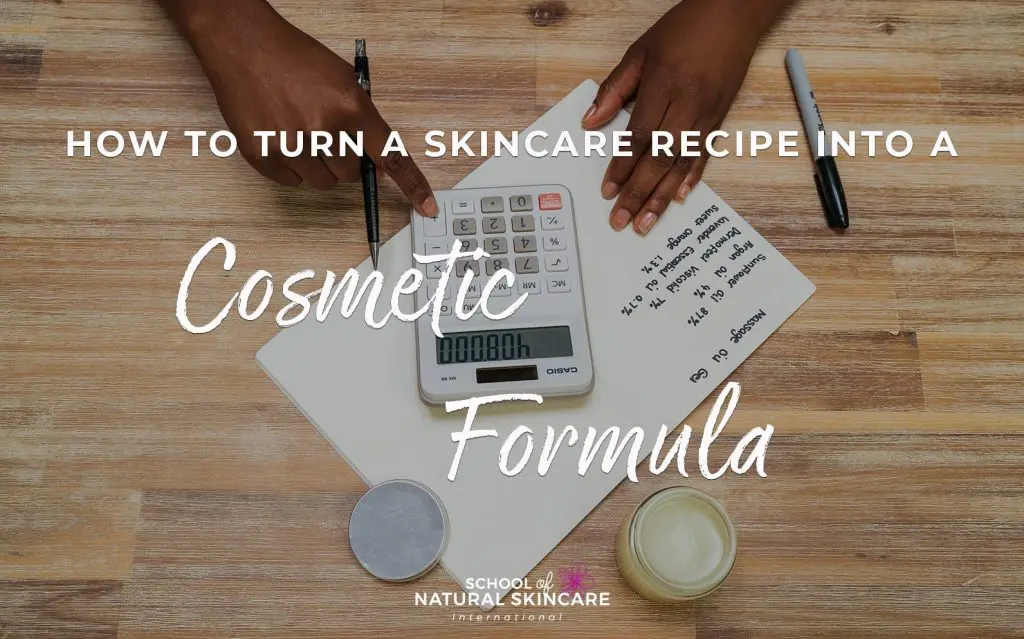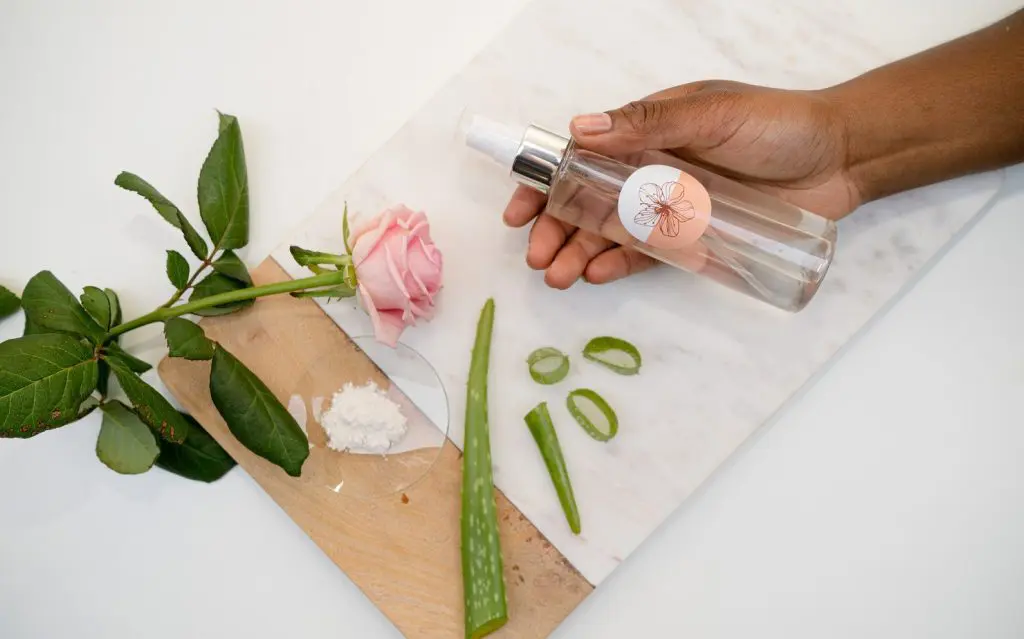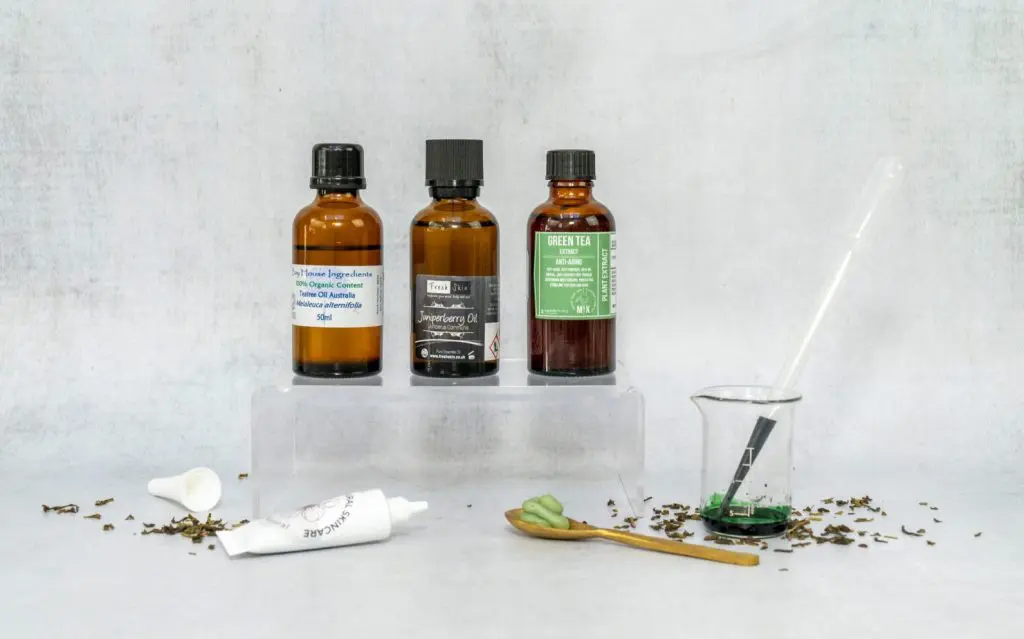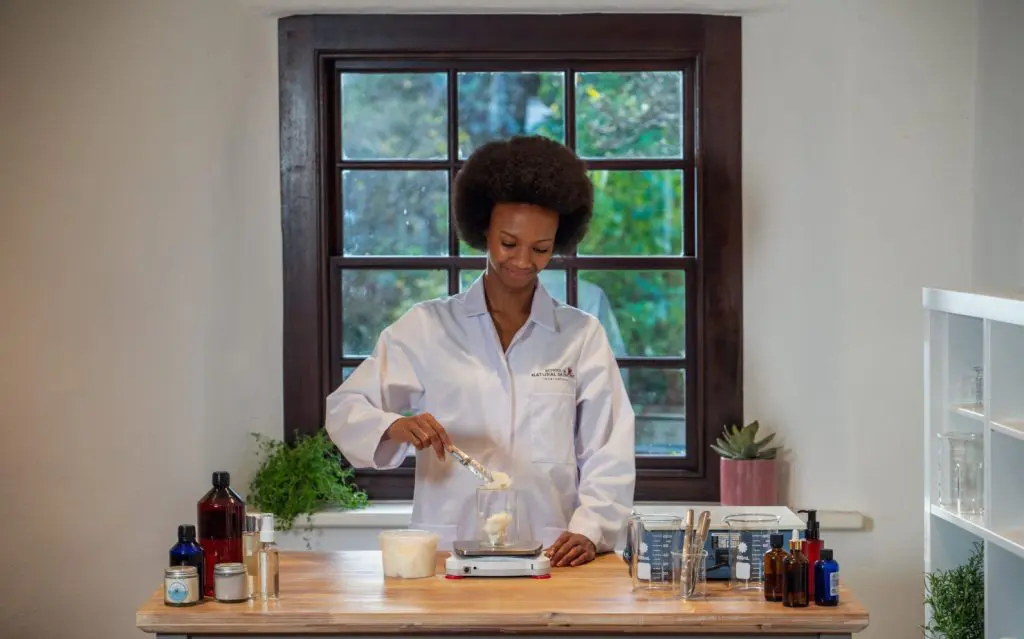If you have been using a natural skincare recipe for a cosmetic product for a while and you like it, you might want to turn it into a cosmetic formula. Professional cosmetic formulas are written in percentages.
Before we look at a cosmetic formula, let us look at a recipe.
You’re probably familiar with following recipes either for cooking or for cosmetics. Recipes tend to be written in a mixture of measurements. They might include grams, ounces, cups, milliliters, teaspoons, even something like a dash or a pinch. Here is an example of how a food recipe might be written:
Pancake recipe 1
135g/4¾oz plain flour
1 tsp baking powder
1/2 tsp salt
2 tbsp caster sugar
130ml/4½fl oz milk
1 large egg, lightly beaten
2 tbsp melted butter
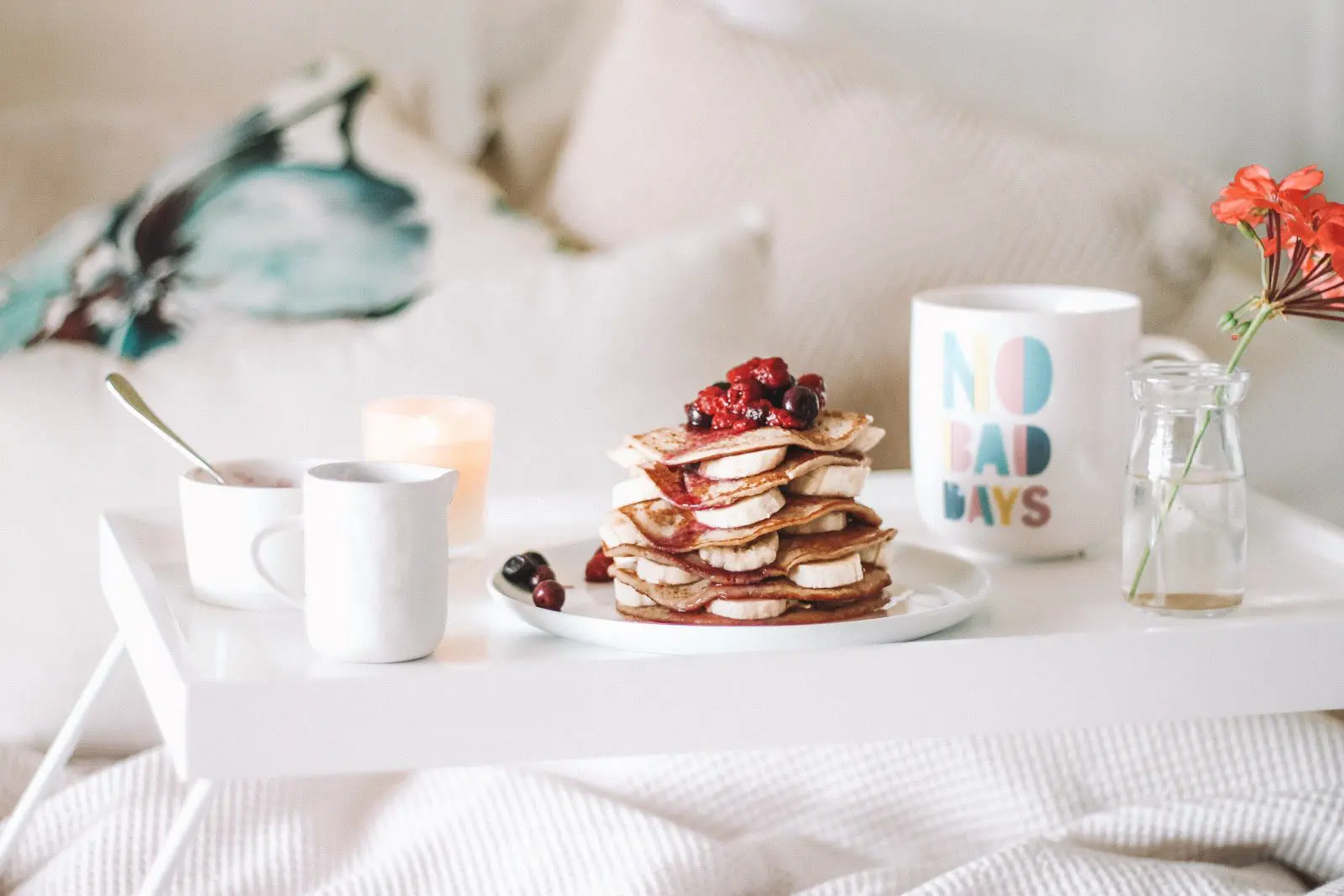
This recipe uses completely mixed measurements; ounces, teaspoons, tablespoons and fluid ounces. There is no consistency with the measurements that are being used.
This can be acceptable for cooking, but we do not want to do this when we are making natural skincare cosmetics. You will find a lot of natural cosmetic ‘recipes’ online, for example in blogs, and they will be written in a similar way to food recipes, and using mixed measurements. Here is an example:
Lip Balm
2 tbsp beeswax pastilles
2 tbsp shea butter
2 tbsp coconut oil
30 drops of peppermint essential oil
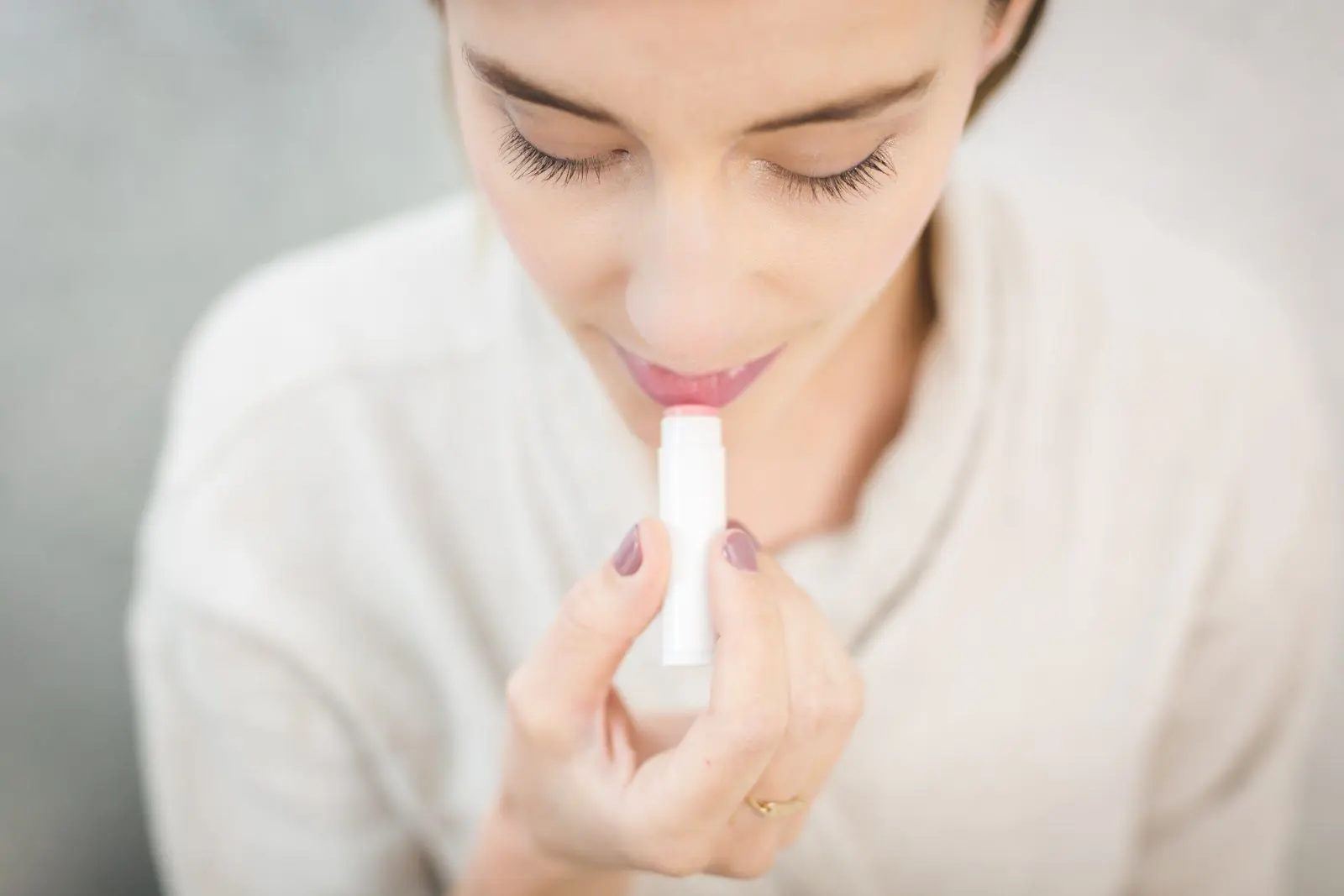
As you can see, there is no consistency in the way they are measuring their ingredients. Plus they are not very precise or accurate.
For professional natural skincare product creators and formulators, this is not an acceptable way to record your product formula. Professional formulators will record natural cosmetic formulas very differently and we are going to show you how to do that next.
Why is it important to use a cosmetic formula and not a skincare recipe?
There are quite a few reasons why it is important to use a skincare formula and not a skincare recipe!
Firstly, a skincare formula is universal – this means that your natural skincare formulation can be understood and used anywhere in the world. It is the most accurate way of recording the details about your natural skincare product.
You can see, at a glance, if the ingredients are being used in safe levels. So, for example, if you know that you can only use 1% essential oil, but your natural skincare product is written as a cosmetic recipe, not a formulation, and it is written in drops and the formulation does not add up to 100%, then you have no idea how much essential oil is being included in percentages.
Whereas if everything is written in percentages in the first place, you can see at a glance if your ingredients are being used in safe levels.
Secondly, a skincare formula ensures consistency and eliminates mistakes.
It means you can easily make different batch sizes. So whether you want to make a small number of products, or a large number, it is very easy to use your formula to scale up or down and make different batch sizes.
Thirdly, you can also easily adapt, vary, or perfect your skincare formula. So you can see, for example, in the lip balm formulation, if you wanted it to be a bit firmer and to achieve this you wanted to increase the amount of beeswax, it is very easy to add on a couple of percentage points to that ingredient and then take away a couple of percentage points from the carrier oil.
It is very simple in a natural skincare formulation to play around, adapt and vary some of the ingredient amounts.
Lastly, formulas form part of the documentation you need if you are making a natural skincare product with the intention of selling it.
If you are selling your natural skincare product, you will be required to keep a file about each of your products and the natural skincare formulation will be one part of the documentation you need to keep. It is also what you would give to a safety assessor – if you’re having your natural skincare product tested, they would want to see the formula.
Skincare formulas would also be needed if you planned to outsource the manufacturing of your natural skincare product either to another small-scale individual perhaps, or to a larger manufacturing firm. They could precisely and confidently replicate your product to your exact specifications.
How to write a cosmetic formula
A formula is the proper or professional way to create and write what is essentially a skincare recipe, and you will notice straight away that the biggest difference is that in a formula the amount of each ingredient is written as a percentage. Your natural skincare formula should also include some key information about your natural skincare product.
For every ingredient, include:
- The INCI name. (This stands for the International Nomenclature of Cosmetic Ingredients.)
- The trade name.
- The function.
- The supplier.
- The percentage of that ingredient in your product (w/w%).
- You also might like to include a phase.
Your natural skincare formula must always equal 100%. So whenever you have created a formula, you must always add up all the percentages and make sure it comes to 100%.
If it does not, then you need to adjust it until it does.
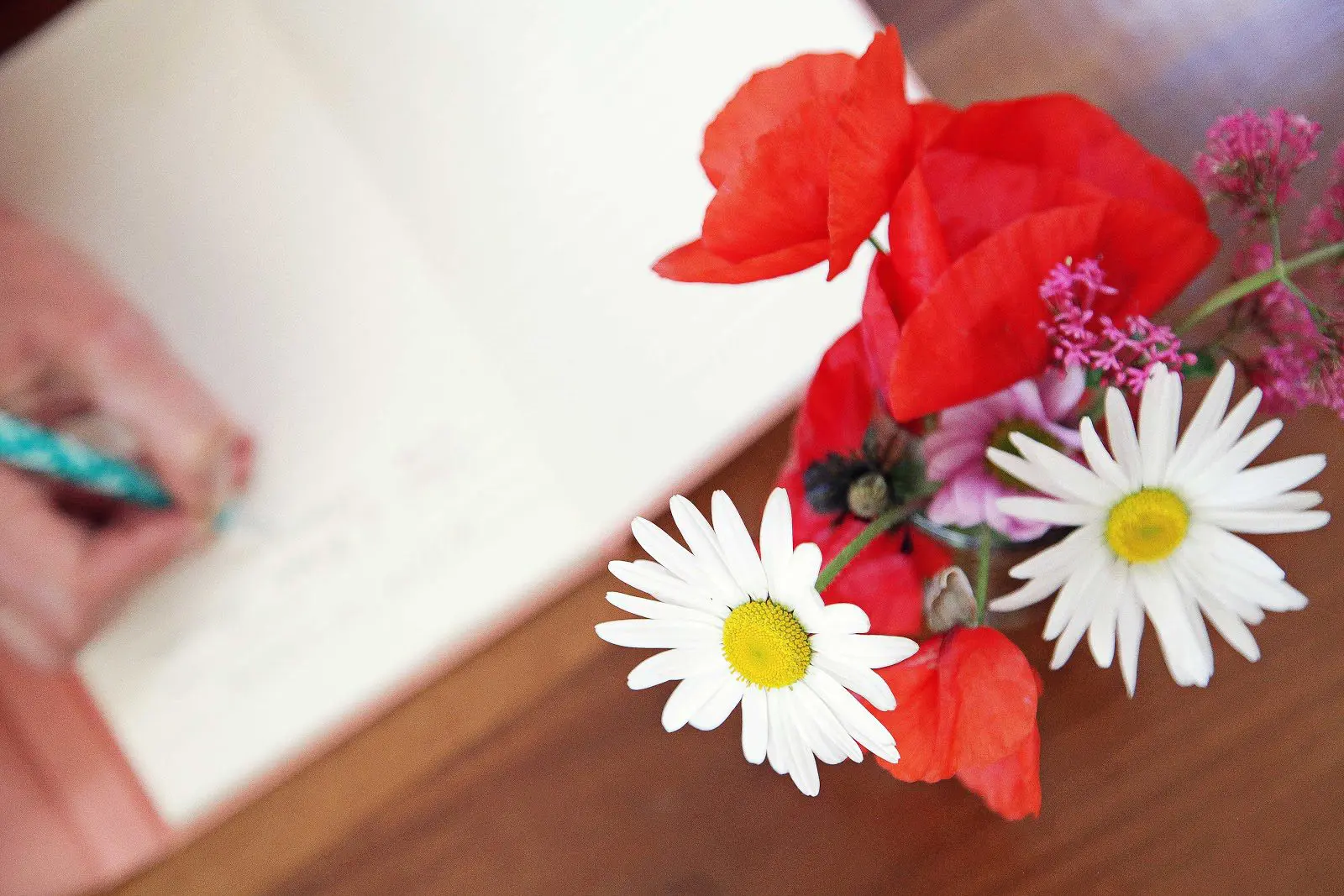

Also, the order in which you write your natural skincare ingredients is important. They need to be listed in decreasing order of concentration. This means you start with the highest amount (the first ingredient you list will be the one that is present in the highest amount in your product), down to the last ingredients (which will be those used in the lowest amounts). Fragrance and colorants are always listed at the end.
Turning a natural skincare recipe into a cosmetic formula
Now that you know what a formula is and why it is important, let’s have a look at how to actually turn a natural skincare recipe into a formula. This part will require some math skills – we will be calculating percentages, along with using a precision scale.
Step 1. Convert all the ingredients in a recipe into weight units, ideally grams.
If your natural skincare recipe calls for mixed measurements like tablespoons, cups, drops or any kind of volume units (milliliters, fluid ounces, etc), you will need to weigh each of those amounts and make a note of how many grams it weighs. It is really important to measure ALL of the ingredients, including liquid ones, in grams.
Example: We will use the lip balm natural skincare recipe from above.
We will use a precision scale so we can measure how many grams each of these ingredients’ quantities weighs, and we will make a note of the weight in the table below.
| Ingredient | Amount in common units | Weight (in grams) |
| Beeswax | 2tbsp | 18g |
| Shea butter | 2tbsp | 28g |
| Coconut oil | 2tbsp | 27g |
| Peppermint essential oil | 30drops | 1g |
If your natural skincare recipe is already in grams, you can skip step 1.
Step 2. Convert grams into percentages
Now we are going to do some math!
In mathematics, a percentage is a number or ratio expressed as a fraction of 100. One percent (1%) means 1 per 100.
For example, a half can be written in percentages as 50%, in fractions as ½ and in decimals as 0.5. 50% actually means 50/100. So if we want to calculate the ratio each of the ingredients represent in a natural skincare recipe, we first need to calculate the sum of all ingredients.
If we use the same example as before, this would mean:
18 g + 28 g + 27 g + 1 g = 74 g
| Ingredient | Weight (in grams) |
| Beeswax | 18g |
| Shea butter | 28g |
| Coconut oil | 27g |
| Peppermint essential oil | 1g |
| SUM | 74g |
Now we have to calculate the percentage of each ingredient. We do this by dividing the weight of one ingredient with the total weight of the natural skincare recipe and then multiplying this result with 100.
For beeswax, the calculation would go:
18g / 74g = 0.243
0.243 x 100 = 24.3
Our formulation table now looks like this:
| Ingredient | Weight (in grams) | w/w% |
| Beeswax | 18g | 24.3 |
| Shea butter | 28g | 37.8 |
| Coconut oil | 27g | 36.5 |
| Peppermint essential oil | 1g | 1.4 |
| SUM | 74g | 100% |
We are rounding the number of percentages to one decimal point. If all the calculations are done correctly, the sum of all percentages will equate to 100%.
In formulation tables, the percentages of ingredients are labelled as w/w%. This is the percentage, by weight, of the ingredients, of the total weight of the mixture. What this means is the number of grams of that ingredient in 100 grams of mixture.
You always weigh your natural skincare ingredients for accuracy and consistency, even if you are using a mixture of liquids and solids. (Weight is used rather than volume, even for liquids, because volume changes according to temperature.)
Step 3. Add additional information into the formulation
The formulations usually include INCI names of the ingredients, trade names of ingredients, their functions and sometimes the supplier of an ingredient too. You can also include information about phases in your natural skincare formula.
What is INCI?
INCI stands for the International Nomenclature of Cosmetic Ingredients. This is essentially a universal, worldwide system of proper names for cosmetic ingredients and it is based on the Latin or scientific name.
This is why, in many countries, regulations will require you to use the INCI name on the natural skincare product label.
Another important reason for using this INCI name is there may be several different common names used for an ingredient, so by using the INCI name, you can be 100% sure of the actual ingredient that you are supposed to be including.
An example in our natural skincare formula above is cocoa butter. Cocoa butter is its trade name or common name, but the INCI for cocoa butter is Theobroma Cacao (Cocoa) Seed Butter. So that is the term that you would include in your natural skincare formula under the INCI column, with each word starting with a capital letter.
What is the trade name and why include it?
The trade name is essentially the name under which the ingredient is sold. It is good to include the trade name as well as the INCI name as natural skincare ingredients with the same INCI name can sometimes have several trade names, and by recording the one which you have used in your natural skincare formulation, you can ensure you use the same ingredients every time.
Also, when you are making up the formula, it prevents any mix-ups occurring because you yourself are probably most familiar with the trade name.
What is the function and why include it?
Function is another detail which you could include in your natural skincare formula, so that you have a record of how the ingredient will function in your formula – what role it has or what it will do in your natural skincare product.
This is really helpful if you want to adjust your formula later.
So, for example, in the natural skincare formula above for a lip balm, you may create this formula and then go back and adjust it. You may want to, for example, make it firmer or softer. Beeswax is an ingredient here that adds the body and firmness to a product, so by listing the function as you are creating your formula, it is very easy to go back later and identify which ingredients you’ll need to vary.
What is the phase in a cosmetic formula?
This information helps you to produce the natural skincare product correctly because some products are made in different phases.
You may have a natural skincare product that is really easy to make and it only has one phase, which means all the ingredients are simply mixed together and that is it – the product is finished. But other natural skincare products might be made by more than one phase.
A cream or lotion would usually include three phases.
In our example of a lip balm, we have two phases: Phase A and Phase B. Phase A is the phase that is heated, so all those ingredients are heated. In the next phase, B, are the ingredients included when the mixture has been removed from the heat.
So by listing the phase in your formula, it is then really easy when you are making your natural skincare product to assemble all the ingredients you need for different phases and to know which ingredient goes in which phase. This will also help you make your natural skincare product in the same way every time, to help you achieve the same result every time.
Now we will add all the key information and turn the lip balm natural skincare recipe into a professional looking natural skincare formulation.
| Phase | INCI name | Trade name | Function | w/w% |
| A | Cera Alba | Beeswax | Thickener, occlusive | 24.3 |
| A | Butyrospermum Parkii (Shea) Butter | Shea butter | Emollient | 37.8 |
| A | Cocos Nucifera (Coconut) Oil | Coconut oil | Emollient | 36.5 |
| B | Mentha Piperita (Peppermint) Oil | Peppermint essential oil | Fragrance | 1.4 |
How do you begin formulating your own natural skincare products?
If you are interested in learning more about formulating your own natural skincare products rather than following other people’s recipes – whether you want to make them for yourself or to sell – our Diploma in Natural Skincare Formulation is a 14-module online course dedicated to this topic.
You will learn the practice, art and science of natural skincare formulation in an accredited, multimedia course.
It is fully online, allowing you to study at your own pace, in your own time, from wherever you are in the world.
Plus, when you join you can get started straight away and you will be invited to join our vibrant and collaborative online student and graduate community with passionate natural beauty lovers from all around the world following the same path as you.
If you are not quite ready for that yet, why not take a look at our Beginner’s guide to formulating natural skincare products and learn a little more about formulating your own natural skincare products.
Finally, if you have found this article useful, you will probably also want to read the article we wrote about how to do it the other way around. Here we learned how to turn a natural skincare recipe into a natural cosmetic formula, but in this article we wrote about How to turn a cosmetic formula into a recipe!
Free Guide
The Beginner's Guide to Formulating Natural Skincare Products (From scratch, like a professional!)
Start creating your own natural skincare products from scratch – rather than simply following recipes!
Learn how to formulate like a pro and discover our top tips for becoming a confident skincare formulator.
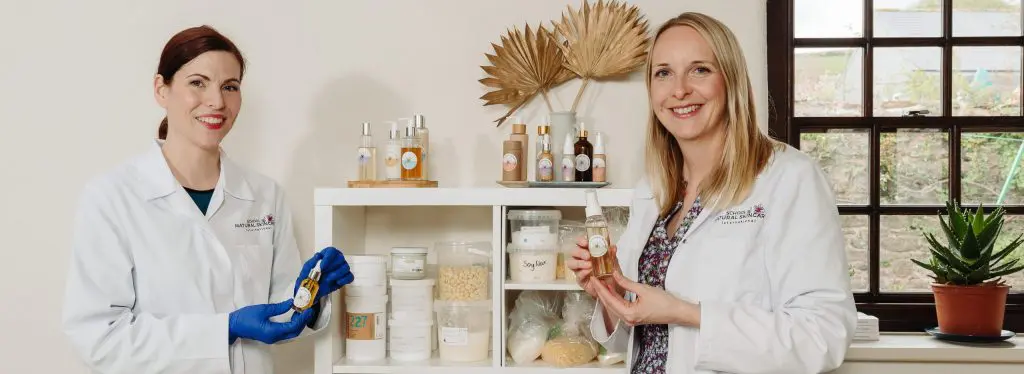
Exclusive for our newsletter subscribers. Sign up now.
We look after your data in accordance with our privacy policy.
Download this fabulous guide and you’ll learn:
- What formulating is and why you need to be doing it!
- The difference between following recipes and formulating your own products.
- Our step-by-step process to designing products people love.
- Four easy ways to personalize your skincare products.
- Choosing the right carrier oils for your beauty products.
- Plus, you’ll get our Safe Product Checklist: How to make sure the skincare products you make are safe and stable
Loved learning about this? Make sure to remember by pinning this article!
